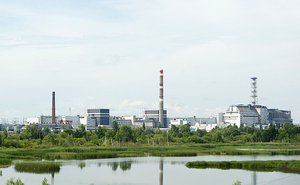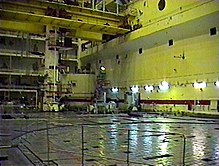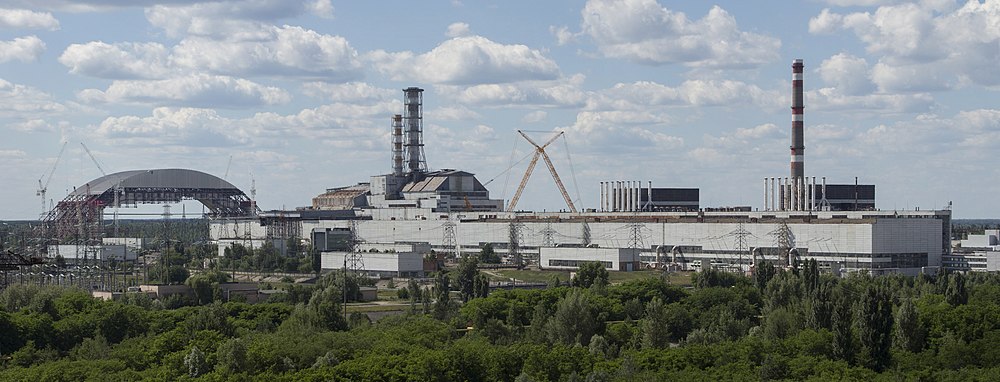Chernobyl nuclear power plant
| Chernobyl nuclear power plant | ||
|---|---|---|
| The Chernobyl Nuclear Power Plant from Pripyat seen from (2009) | ||
| location | ||
|
|
||
| Coordinates | 51 ° 23 '23 " N , 30 ° 5' 59" E | |
| Country: |
|
|
| Data | ||
| Owner: | NAEK Energoatom (НАЕК Енергоатом) | |
| Operator: | Ministry of Fuel and Energy (Mintopenergo) of Ukraine | |
| Start of project: | 1970 | |
| Commercial operation: | May 27, 1978 | |
| Shutdown: | December 16, 2000 | |
|
Active reactors: |
BZ 700 | |
|
Decommissioned reactors (gross): |
4 (3800 MW) | |
|
Construction discontinued (gross): |
2 (2000 MW) | |
| Energy fed in since commissioning: | 271,262.82 GWh | |
| Website: | chnpp.gov.ua | |
| Was standing: | June 4, 2011 | |
| The data source of the respective entries can be found in the documentation . | ||
The decommissioned Chernobyl Nuclear Power Plant ( Ukrainian Чорнобильська АЕС ( Tschornobylska AES ), Russian Чернобыльская АЭС им. В. И. Ленина ( Tschernobylskaja AES in. WI Lenina ), translated "the Chernobyl nuclear power plant named W. I. Lenin ") is located on the banks of the river Pripyat in the north the Ukraine near the Ukrainian-Belarusian border . It is about four kilometers from the city of Pripyat and 18 kilometers from Chornobyl . The Chernobyl nuclear disaster , in which the reactor in Unit 4 exploded on April 26, 1986 , is considered to be the world's most serious accident to date in a nuclear power plant . The remaining reactor units 1 to 3 were decommissioned between 1991 and 2000.
Reactor technology
The reactors planned and used for Chernobyl were of the type RBMK -1000 of the first (units 1 and 2) and second generation (units 3 and 4). These graphite-moderated reactors have serious safety deficiencies. Each reactor was assigned two generators, which were housed in a turbine hall that was almost 800 meters long, common to all four blocks. The roof of the hall partially collapsed on February 12, 2013 70 meters from the sarcophagus on an area of 600 m² under snow load.
The reactors had a total gross electrical output of 3800 megawatts . Between 1983 and 1986 the power plant had a maximum thermal output of 12,800 megawatts.
On April 23, 2008, the last nuclear fuel was removed. On the same day, the vector nuclear waste processing plant in the zone at the power plant went into operation. It is planned to start processing the contaminated parts in the zone in order to prepare them for final storage.
Construction and operation
The power plant was originally planned with a capacity of 2000 MW. There were three different reactor types to choose from; two RK-1000 , four WWER-440 or two RBMK-1000 . After precise planning of the project, two reactors of the type RBMK were chosen due to their economic efficiency (decision of the Council of Ministers of the Soviet Union of June 19, 1969/14 December 1970). This made Chernobyl the third plant with reactors of the type RBMK-1000.
During the construction period, further blocks were planned and the expansion to up to six blocks was approved. The power plant in its present form was built between 1970 and 1983. At the end of the 1960s / beginning of the 1970s, a cooling lake was created on the Pripyat especially for the power plant . The cooling lake was expanded with the construction of units 5 and 6. Even after the disaster in Unit 4, after an interruption, the other reactor units of the Chernobyl nuclear power plant were used to generate electricity until December 2000. The power plant was regarded as a model plant in the Soviet Union in the 1980s.
Block 1
Block 1 was completed in 1977. On September 1, 1982, a central fuel assembly was destroyed by overheating as a result of an operator error. Considerable amounts of radioactivity leaked out and the radioactive gases reached the city of Prypiat . During the repair work, various workers were exposed to a significantly excessive dose of radiation; the accident is listed as INES 5. Unit 1 finally went offline in November 1996 after the operating time had been extended for the last time by three years by resolution of October 20, 1993.
Block 2
Block 2 was completed in 1978. For a long time, there was a leak in the spent fuel pool. The leakage of small amounts of radioactivity is suspected. On October 11, 1991, after a hydrogen explosion, there was a major fire in the turbine hall, the roof partially collapsed and one of the two generators was badly damaged. Since the manual reactor shutdown was successful, the reactor itself was only minimally damaged and hardly any radioactivity escaped. After cost estimates for a possible repair, repairs were initially waived and waited. In 1991, at the time of the collapse of the Soviet Union , the Ukrainian government decided to hold Block 2 on hold for the time being. On October 20, 1993, the decision was revised, the operating license for Unit 2 withdrawn and the reactor finally shut down.
Block 3
Block 3 was completed in 1981. It forms a double block with block 4. With a resolution of October 20, 1993, the service life was extended by seven years. The block was taken offline in December 2000 under pressure and after compensation payments from the European Union .
Block 4
Block 4 was completed in 1983 and forms a double block with Block 3 and the auxiliary system building in between. On April 26, 1986, there was a core meltdown and explosion of the reactor core , which completely destroyed the block. Large parts of the radioactive inventory ended up in the environment. The graphite used to moderate the reactor caught fire and could only be extinguished days later. The area around the reactor had to be cleared and is still uninhabitable today. The came with the smoke up very high radioactivity was driven to the West and led to a fallout (fallout) over northern and central Europe. This accident made the place name “Chernobyl” a synonym for the dangers of nuclear energy and the unforeseeable consequences of a catastrophe .
Blocks 5 and 6
Blocks 5 and 6 were under construction from 1981 onwards, somewhat apart from blocks 1 to 4. Unit 5 should have started trial operation in the autumn of 1986; Unit 6 was halfway finished in 1986. Despite the accident in Block 4, work continued on both blocks. Due to the high level of radioactivity in the area, construction work had to be stopped on January 1, 1988. Both blocks were protected from weathering and aging with a protective coating . The USSR planned to complete the two blocks after the radioactivity subsided. The new political situation in the 1990s made it impossible to implement this plan, as Ukraine, as the successor state, had neither the political will nor the financial means to complete it.
Work in the nuclear power plant
From the reactor disaster in 1986 to the shutdown of the last unit in 2000, up to 9,000 people worked in the power plant. In 2006, around 3,000 people were still employed in monitoring and maintenance work. The power plant, although closed, is by no means deserted. Until 1986, most of the workers came from the city of Pripyat, which was specially built for the power plant . Since Pripyat was evacuated after the reactor disaster, most of the workers today come from Slavutytsch , the replacement city for Pripyat built after the disaster. From 1986 the work - despite the very high radiation exposure - was comparatively attractive: On the one hand, because of extremely good pay, on the other, because of the two-week cycle: two weeks (normal) working hours, two weeks off.
Significance in energy policy
The power plant had a very high energy policy importance for the energy supply of the USSR and especially for its successor state Ukraine. Ukraine therefore suffers particularly from the lack of electricity from the Chernobyl NPP. The nuclear power plant supplied about one sixth of the nuclear power generated in Ukraine, which corresponds to about 4–10% of the total amount of electricity. Only this background makes it possible to explain why the power plant continued to operate for 14 years after the accident and why many people continued to work in this area.
There were three different concepts for replacing the missing capacity: the completion of three safer reactors in Ukraine, the construction of which was already advanced, the construction of a gas-fired power plant with 3,000 MW output near the city of Slavutych , which will give some of the employees of Chernobyl work could, or upgrading some coal-fired power plants. Later, the Khmelnitsky 2 and Rivne 4 nuclear power plant blocks of the VVER-1000 type, each 80% completed, were completed.
Todays situation
After the contract was signed in August 2007, the new protective cover, the New Safe Confinement (NSC) , was built over the old sarcophagus from 2010 to 2016 by the Novarka consortium . For the 26th anniversary, the foundation stone for the NPC of Reactor 4 was laid on April 26, 2012. According to the original plans, the new protective cover should cost around 935 million euros and be completed by October 15, 2015. An impending construction freeze was averted in November 2014 with new financing. On November 14, 2016, work began on moving the new protective cover (also known as the "Arka") towards the sarcophagus. The protective cover reached its final position on November 29, 2016 and should be put into operation in November 2017. However, due to the high levels of radiation in the old building, commissioning was delayed. On April 25, 2019, the European Bank for Reconstruction and Development (EBRD) announced the completion of a 72-hour test run of the protective cover. The official commissioning in the presence of the Ukrainian President Volodymyr Selenskyj took place on July 10, 2019.
The approx. 270 m long, 100 m high and 30,000 t heavy protective cover is currently the largest mobile structure in the world. It is intended to meet the goal of preventing radioactive substances from escaping for 100 years.
In addition to the NSC, other buildings will be erected on the site of the nuclear power plant, which will take on special tasks in the disposal and dismantling of the power plant.
The 75 meter high and very distinctive exhaust air chimney in blocks 3 and 4 was dismantled from October to December 2013 with the help of a large crane so that the new sarcophagus could also be pushed into the specified position.
Data of the reactor blocks
The Chernobyl nuclear power plant has a total of six units :
| Reactor block | Reactor type | Electric net power |
Electric gross power |
Thermal performance |
start of building | Network synchronization |
Commercialization of essential operation |
switching off processing |
|---|---|---|---|---|---|---|---|---|
| Chernobyl-1 | RBMK-1000 | 740 MW | 800 MW | 3,200 MW | 03/01/1970 | 09/26/1977 | May 27, 1978 | 11/30/1996 |
| Chernobyl-2 | RBMK-1000 | 925 MW | 1,000 MW | 3,200 MW | 02/01/1973 | December 21, 1978 | 05/28/1979 | 10/11/1991 |
| Chernobyl-3 | RBMK-1000 | 925 MW | 1,000 MW | 3,200 MW | 03/01/1976 | December 3rd, 1981 | 06/08/1982 | 12/15/2000 |
| Chernobyl-4 | RBMK-1000 | 925 MW | 1,000 MW | 3,200 MW | 04/01/1979 | 12/22/1983 | 03/26/1984 | 04/26/1986 (destroyed) |
| Chernobyl-5 | RBMK-1000 | 950 MW | 1,000 MW | December 01, 1981 | - | - | (Construction discontinued in 1988) | |
| Chernobyl-6 | RBMK-1000 | 950 MW | 1,000 MW | December 01, 1983 | - | - | (Construction discontinued in 1988) |
See also
Web links
- SSE "Chernobyl NPP". Chernobyl Nuclear Power Plant website in English
- Plague: Chernobyl (Ukraine)
- The Chernobyl NPP at the Vienna Environmental Ombudsman
- Spread of the radioactive cloud from the Chernobyl nuclear power plant from April 26 to May 7, 1986 . Metoffice UK. Archived from the original on April 9, 2016.
- Pictures from the disaster area. The long shadow of Chernobyl.
Individual evidence
- ↑ Spelling according to the Russian name until the end of the Soviet Union and especially during the reactor disaster; today's Ukrainian name: Chornobyl
- ↑ Parts of the roof and wall of the exploded Chernobyl reactor collapsed
- ↑ RIA Novosti - 23/04/2008 - http://de.rian.ru/postsovjetischen/20080423/105725425.html
- ↑ Website of the power plant - About the building ( Memento from June 7, 2008 in the Internet Archive ) (English)
- ↑ a b c d Chernobyl reactor accident ( Memento from January 31, 2012 in the Internet Archive ) (PDF; 1.3 MB)
- ↑ a b Archived copy ( Memento of October 27, 2008 in the Internet Archive )
- ↑ Nuclear power in Ukraine ( Memento from November 12, 2010 in the Internet Archive )
- ↑ The Chernobyl NPP . Vienna Environmental Ombudsman. Archived from the original on September 29, 2007. Retrieved April 24, 2006.
- ^ The Chernobyl reactor accident; Publisher: Information Circle KernEnergie Robert-Koch-Platz 4, 10115 Berlin; Editing: Martin Czakainski, Thomas Kinzelmann, Gunter Pretzsch, Volker Wasgindt; Typesetting, layout: T. Espey Typesetting Layout Graphics Consulting, Bonn; Printed by: Druckerei Hermann Schlesener KG, Berlin, 4th edition June 2007; ISBN 3-926956-48-8 ; Pages 46, 58
- ↑ Novarka | Chronology. Retrieved September 9, 2019 (American English).
- ↑ Project "New Safe Confinement Construction" (English) ( Memento of 14 June 2015, Internet Archive )
- ↑ Chernobyl sarcophagus threatens construction freeze . Süddeutsche Zeitung, September 16, 2014
- ↑ Ivo Mijnssen: A sarcophagus for a hundred years . Neue Zürcher Zeitung, December 1, 2014
- ^ Bernhard Clasen: Delay in the construction of the new sarcophagus: Chernobyl and the time . In: The daily newspaper: taz . April 23, 2018, ISSN 0931-9085 ( taz.de [accessed April 24, 2018]).
- ↑ Christoph Seidler: Radiation too high: completion of the Chernobyl sarcophagus is delayed . In: Spiegel Online . December 20, 2017 ( spiegel.de [accessed December 20, 2017]).
- ^ President: This year the commissioning of a new safe confinement of the Shelter object will be completed. April 26, 2018, accessed May 5, 2018 .
- ↑ Chernobyl's New Safe Confinement project completes final commissioning test. April 25, 2019, accessed June 2, 2019 .
- ↑ mdr.de: Protective cover in Chernobyl officially in operation | MDR.DE. Retrieved August 12, 2019 .
- ↑ Protective cover is completed , last accessed on November 29, 2016.
- ↑ Ten meters per hour. Retrieved November 15, 2016 .
- ↑ Chernobyl: Dismantling the ventilation shaft at the Nuclear Forum Switzerland, November 13, 2013
- ↑ Power Reactor Information System of the IAEA : "Ukraine: Nuclear Power Reactors" (English)







